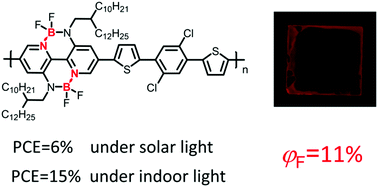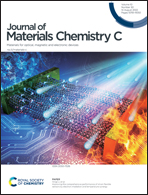A polymer acceptor containing a B ← N unit with strong fluorescence for organic photovoltaics†
Abstract
The power conversion efficiency (PCE) of organic solar cells (OSCs) is limited by the large non-radiation energy loss (ΔEnr), which is due to the low fluorescence quantum efficiency (φF) of typical organic/polymer photovoltaic materials. In this manuscript, we report a polymer acceptor containing a B ← N unit with strong red fluorescence. The polymer, PBN-16, is the alternating copolymer of an electron-withdrawing B ← N-bridged bipyridine (BNBP) unit and an electron-donating 2,5-dithienyl-1,4-dichlorophenylene unit. PBN-16 exhibits φF of as high as 11% in thin film because of the near-unity φF of BNBP itself and the twisted configuration of the polymer backbone. Its all-polymer photovoltaic device shows an open-circuit voltage (VOC) of 1.33 V and a PCE of 6.0% under AM 1.5G illumination as well as a VOC of 1.17 V and a PCE of 15.4% under indoor light-emitting diode illumination. Organic light-emitting diode devices using PBN-16 as an emissive material emit pure red light with a luminance efficiency of 0.99 cd A−1 and CIE coordinates of (0.67, 0.32). These results confirm that conjugated polymers or small molecules containing a B ← N unit are promising for organic solar cells with minimized energy loss and high PCE.



 Please wait while we load your content...
Please wait while we load your content...